from A newsletter for proactive planning... In this edition... Submit your tax return by 30 December to have your tax collected through PAYE Reclaiming section 455 tax paid Can you benefit from the marriage allowance? Reporting payment to HMRC if you pay your employees early in December Depreciation versus capital allowances Tax Diary- December December 2023 Issue www.compassaccountants.co.uk
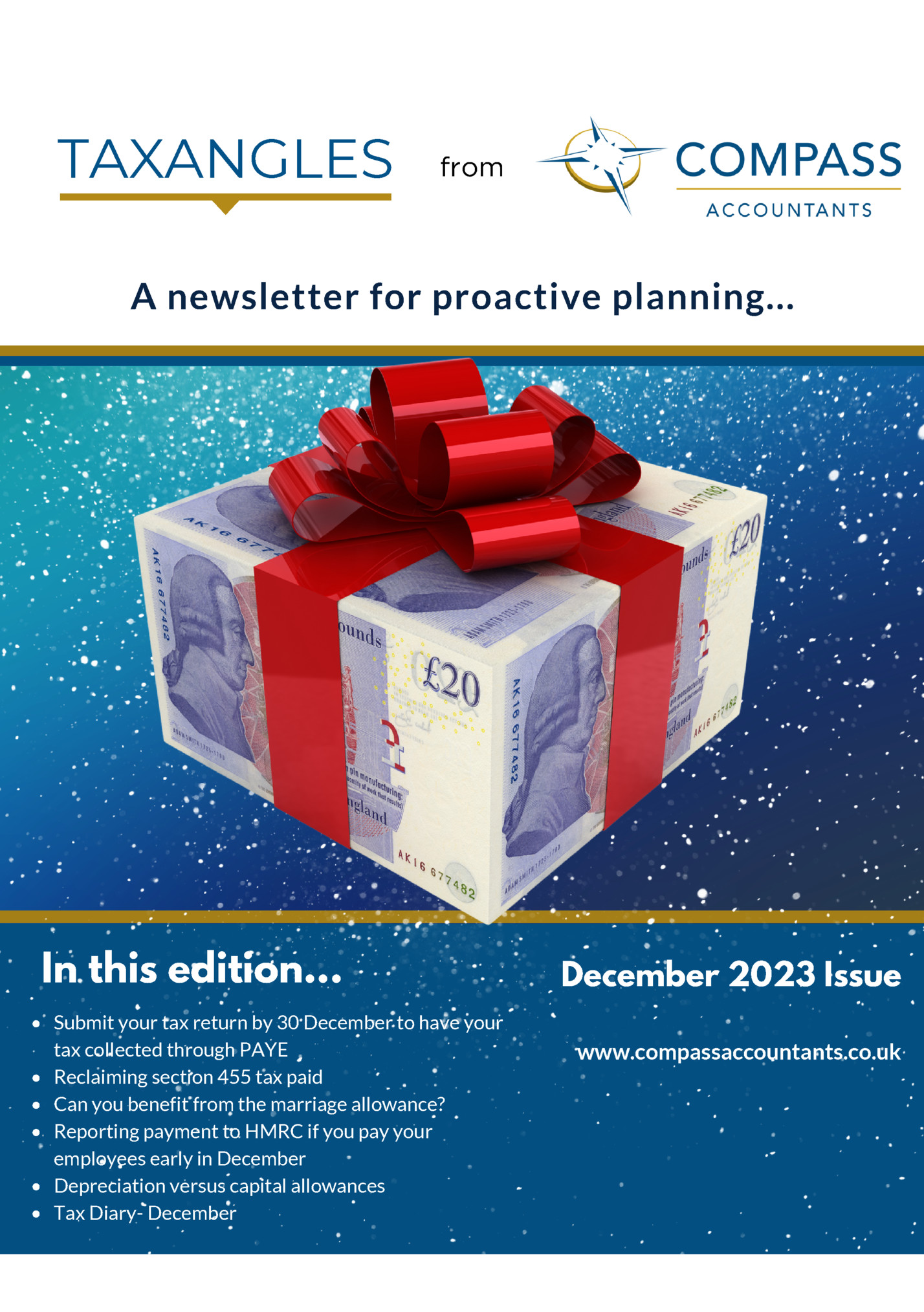
PAGE 2 Submit your tax return by 30 December to have your tax collected through PAYE Although the deadline for submitting your 2022/23 tax return online is midnight on 31 January 2024, if you owe tax and you want to have it collected through PAYE via an adjustment to your tax code, you will need to file your tax return by the earlier date of 30 December 2023. If the option to pay any tax you owe via PAYE is available to you, it can be attractive. Not only are you saved from having to pay the bill in full by 31 January 2024, but you can also pay what you owe in instalments without needing to set up a Time to Pay arrangement. Further, there is no interest to pay – a bonus in times of high interest rates. Qualifying conditions Paying your Self Assessment tax bill through your tax code is only an option if all of the following conditions are met: You owe less than £3,000 in total. You already pay tax through PAYE, for example, because you are an employee or because you receive a company pension. You submitted your 2022/23 tax return online by 30 December 2023 (or filed a paper return by 31 October 2023). It is important to note that if your Self Assessment bill is more than £3,000, you cannot pay it via PAYE – even if you make a part payment to reduce the outstanding amount to £3,000 or less. However, if you are struggling to pay, you may be able to set up a Time to Pay arrangement (which can usually be done online if you owe £30,000 or less). It will not be possible to pay your tax through PAYE if you do not have enough PAYE income for HMRC to collect what you owe or if deducting your Self Assessment tax via PAYE would result in you paying more than 50% of your PAYE income in tax or paying twice as much tax as you usually do. Automatic set-up If you have filed your tax return by the 30 December 2023 deadline and you meet all three of the conditions set out above, HMRC will automatically amend your 2024/25 tax code to collect the tax that you owe under Self Assessment for 2022/23 – you do not need to ask them to do this. If you do not want them to collect tax in this way and you have filed your return by 30 December 2023, you will need to tell them. Your code is adjusted so that you will pay the tax that you owe in 12 instalments over the tax year in addition to the usual deductions from your pay. For example, if you owe £1,200 and you are a basic rate taxpayer, your personal allowances will be reduced by £6,000, so that if you receive the personal allowance of £12,570, your code for 2024/25 will be 657L. You will pay an additional £100 a month in tax as a result for 2024/25.
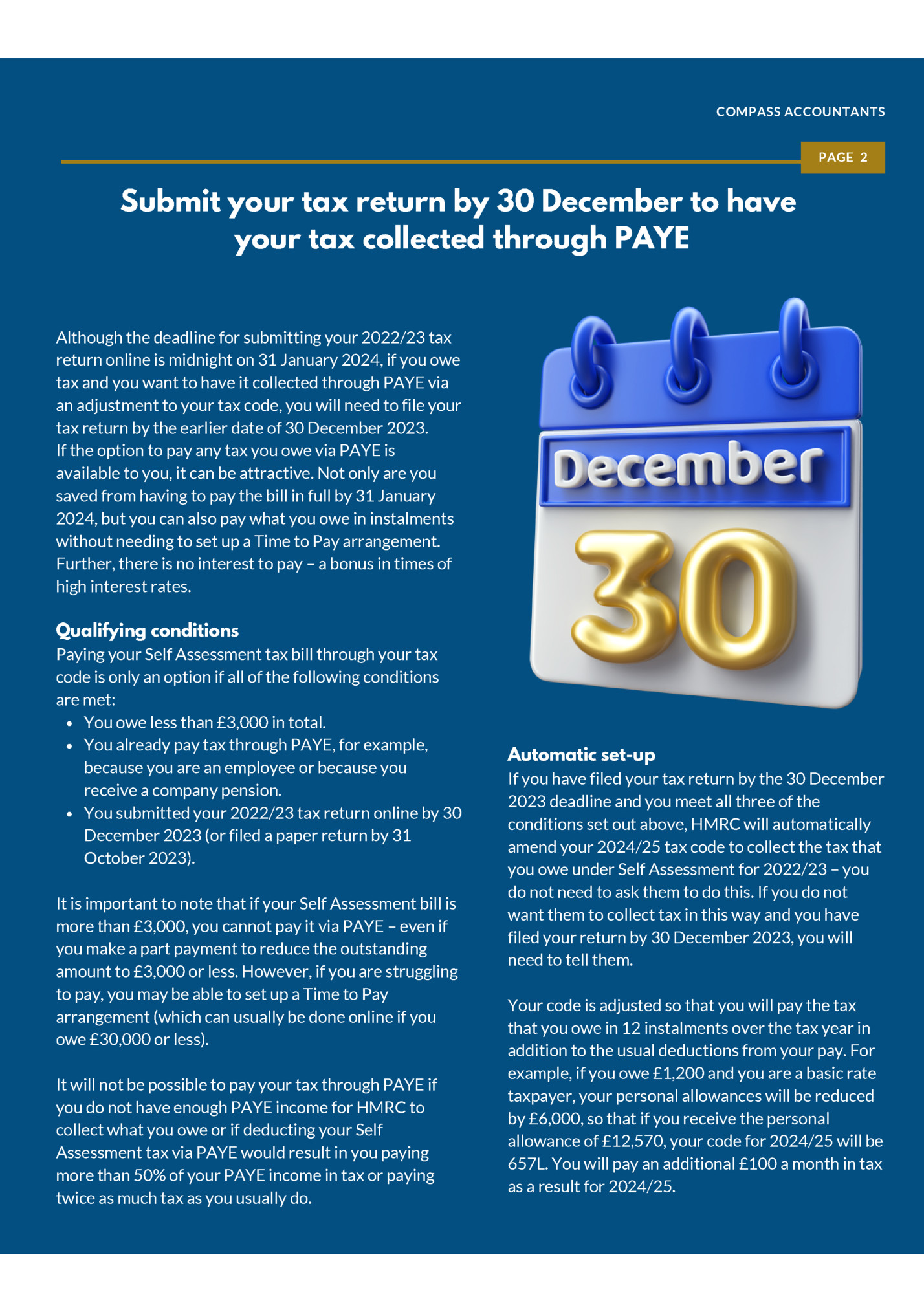
PAGE 3 Reclaiming section 455 tax paid In personal and family companies, directors often borrow money from the company as this is a cheaper and easier option than taking out a commercial loan. However, there can be tax consequences for both the director and the company. If the loan balance exceeds £10,000 at any point in the tax year, a tax charge would arise under the benefit in kind rules if the interest paid by the director on the loan, if any, is less than that which would be payable at the official rate. The taxable amount is the interest due at the official rate, less any interest paid by the director. The company must also pay Class 1A National Insurance on the taxable amount. Further tax consequences arise if the company is a close company (as most personal and family companies are) and the director’s loan account is overdrawn at the year end and remains so at the corporation tax due date nine months and one day after the year end. A close company is, broadly, one controlled by five or fewer people. Where this is the case, the company must pay tax on the outstanding loan balance. This tax is known as section 455 tax. If the loan is outstanding at the year end but cleared before the corporation tax due date, there is no section 455 tax to pay, but the loan must be reported on the company tax return. The rate of section 455 tax is linked to the dividend higher rate, and is 33.75% in respect of loans made on or after 6 April 2022. Although paid at the same time as corporation tax, section 455 tax is not corporation tax and, crucially, is a temporary tax as it becomes repayable once the loan balance is cleared. The tax can be reclaimed nine months and one day after the end of the accounting period in which the loan was repaid, released or written off. The tax becomes repayable on the day that the corporation tax for the period is due. To reclaim the tax, the loan does not need to be cleared in full – if part of the loan balance is repaid, released or written off, you can reclaim the tax due on that part of the loan. A claim can be made on form L2P. This can be done online by visiting the Gov.uk website at www.gov.uk/guidance/reclaim-tax-paid-by-closecompanies-on-loans-to-participators-l2p. A claim can be made by your agent on your behalf. To make a claim, you will need your Unique Taxpayer Reference (UTR) and your bank details to hand. You will also need to provide the following information: the start and end dates for the accounting period in which the loan was made; the date the loan was made; the start and end dates for the accounting period when the loan, or part of the loan, was repaid, released or written off; the date that the loan, or part of the loan, was repaid, released or written off; the amount of the loan or part of the loan repaid, released or written off; and the date when the relief is due. Once a claim has been submitted, HMRC will issue a revised tax calculation showing what is owed. The reclaimed tax will be set against any corporation tax owed to HMRC in the first instance, with any excess being repaid by HMRC.
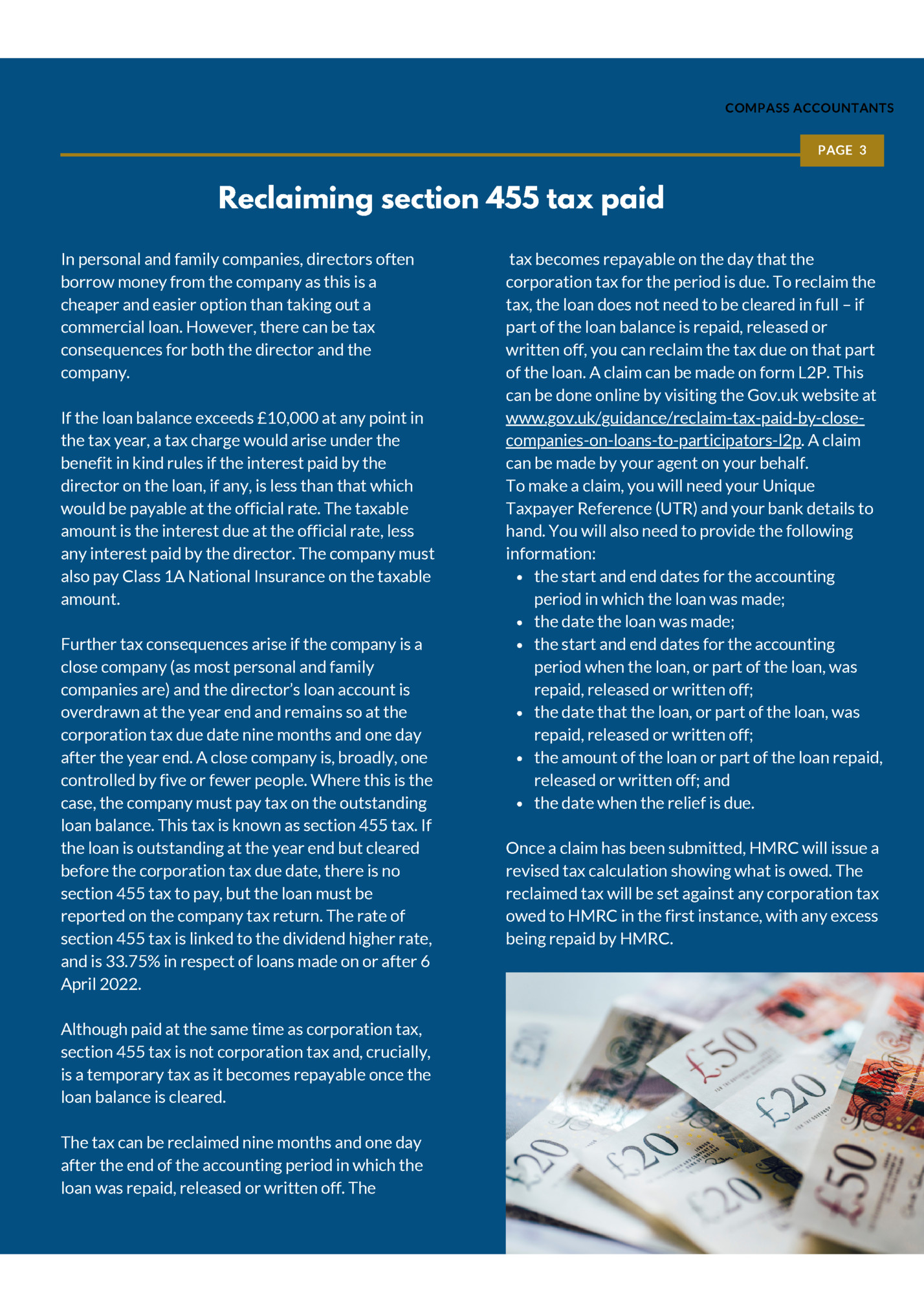
PAGE 4 Can you benefit from the marriage allowance? The marriage allowance is not a separate allowance as such – rather, it is a transfer of part of one spouse or civil partner’s personal allowance to their spouse or civil partner. It should not be confused with the married couple’s allowance which is available where at least one spouse or civil partner was born before 6 April 1935. The marriage allowance allows one spouse or civil partner to transfer 10% of their personal allowance (as rounded to the nearest £10) to their spouse or civil partner. However, the transfer is not permitted if the recipient pays tax at the higher or additional rate. For 2023/24 the personal allowance is £12,570 and the marriage allowance is £1,260. Claiming the marriage allowance is beneficial if one spouse or civil partner is unable to use their personal allowance in full, and the other pays tax at the basic rate. Utilising the allowance can save a couple up to £252 in tax in 2023/24 (£1,260 @ 20%). The only permitted transfer is £1,260 – it is not possible to transfer more of the personal allowance where this is unused or less if the amount unused is less than £1,260. However, if the unused personal allowance is less than £1,260 and making the transfer would mean that overall, the couple would pay less tax, it would be beneficial (although it may mean that some tax is now payable by the transferor). Where the marriage allowance is claimed, the personal allowance of the spouse or civil partner making the transfer is reduced by £1,260 to £11,310, whereas the recipient’s personal allowance is increased to £13,830. Older couples benefiting from the married couple’s allowance cannot also claim the marriage allowance. Making a claim A claim can be made online by visiting the Gov.uk website at www.gov.uk/apply-marriage-allowance. The claim can be made for the current tax year and also for 2019/20 and any later tax year for which the couple were eligible to make the claim. Once a claim has been made, it will apply for subsequent tax years until the claim is cancelled. This too can be done online. Claims for the allowance can also be made through Self Assessment or by completing the marriage allowance form MATCF (see www.gov.uk/guidance/apply-for-marriage-allowance-by-post) and sending it to the address on the form. cont on page 6
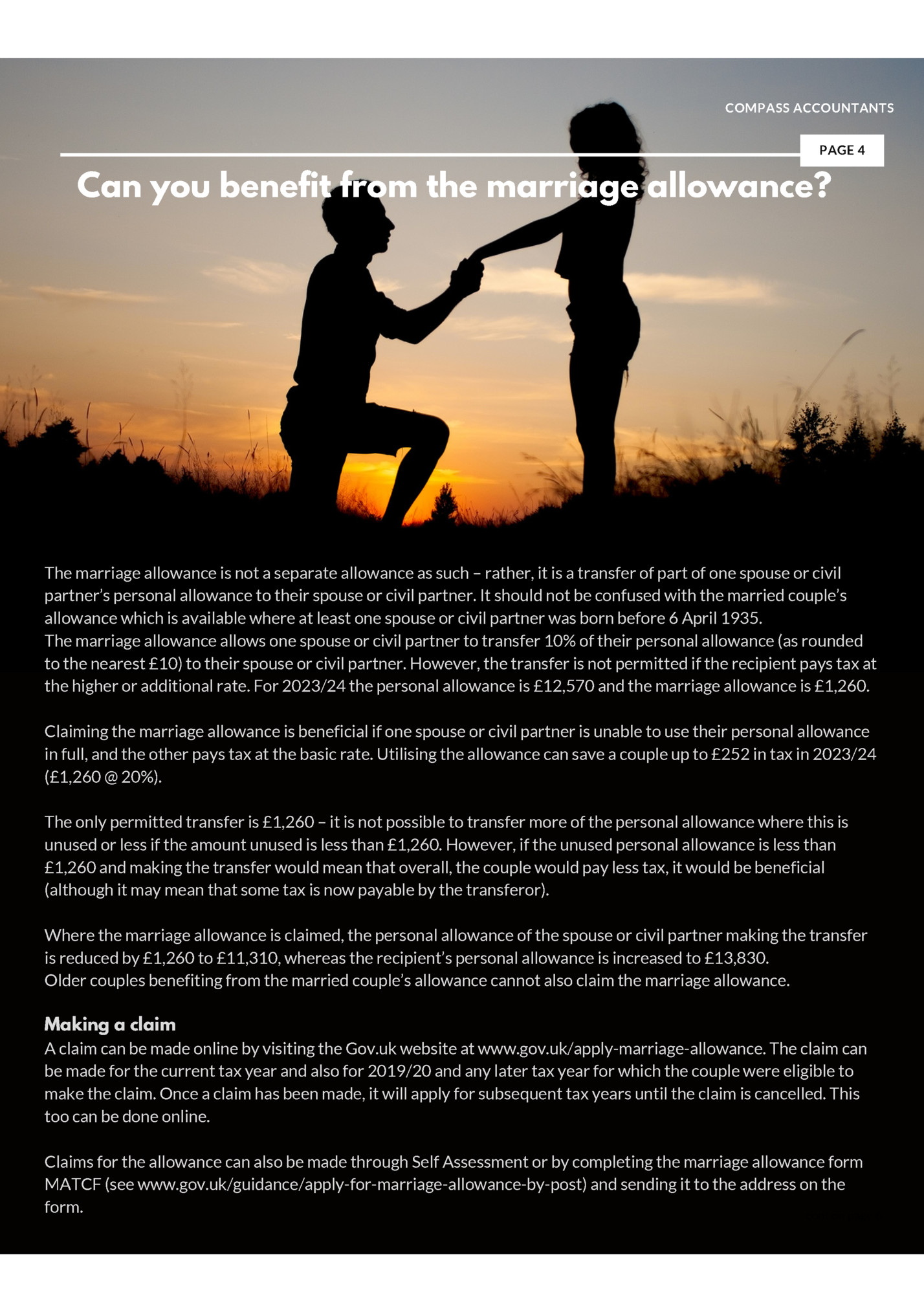
PAGE 5 Example 1 Alex and Anna are married. Alex earns £30,000 a year. Anna looks after their young daughter and has no income in 2023/24. The couple claim the marriage allowance. As a result, Alex’s personal allowance is increased by £1,260, reducing the tax that he pays by £252. Example 2 Jake and John are in a civil partnership. Jake works part-time while studying and earns £12,000 in 2023/24. John has income of £40,000 in 2023/24. Jake is only able to use £12,000 of his personal allowance, leaving £570 unused. Although he cannot tailor the marriage allowance to transfer this to John, a claim is still worthwhile. Making the claim will reduce Jake’s personal allowance by £1,260 to £11,310. As a result, he will now have to pay a small amount of tax as his income exceeds his reduced personal allowance by £690, generating a tax liability of £138 (£690 @ 20%). However, John’s personal allowance will increase by £1,260, reducing the tax that he pays by £252. Overall, despite the fact that Jake must now pay some tax, the couple’s combined tax bill is reduced by £114 (£252 − £138) as a result of claiming the allowance. Depreciation versus capital allowances Tax and accounting rules are not identical and it is sometimes necessary to adjust the accounting profit to arrive at the profit for tax purposes. One area where the rules differ is in the write-off of capital expenditure. For accounting purposes, depreciation is charged to the accounts so as to write off the asset over its useful economic life. This may, for example, be on a 33% reducing balance basis or on a 25% straight line basis. By contrast, for tax purposes, relief for capital expenditure is given by way of capital allowances. The capital allowances that are available depend on the nature of the asset, and there may be more than one possible claim. For example, qualifying expenditure on plant and machinery may benefit from the annual investment allowance (AIA) which allows a 100% deduction for the expenditure in the year in which it is incurred up to the £1 million AIA limit. Where the AIA is not available, or the taxpayer does not wish to claim it, writing down allowances are given at the rate of 18% for main rate expenditure and at 6% for special rate expenditure. Companies can also benefit from full expensing on qualifying new cont on page 6
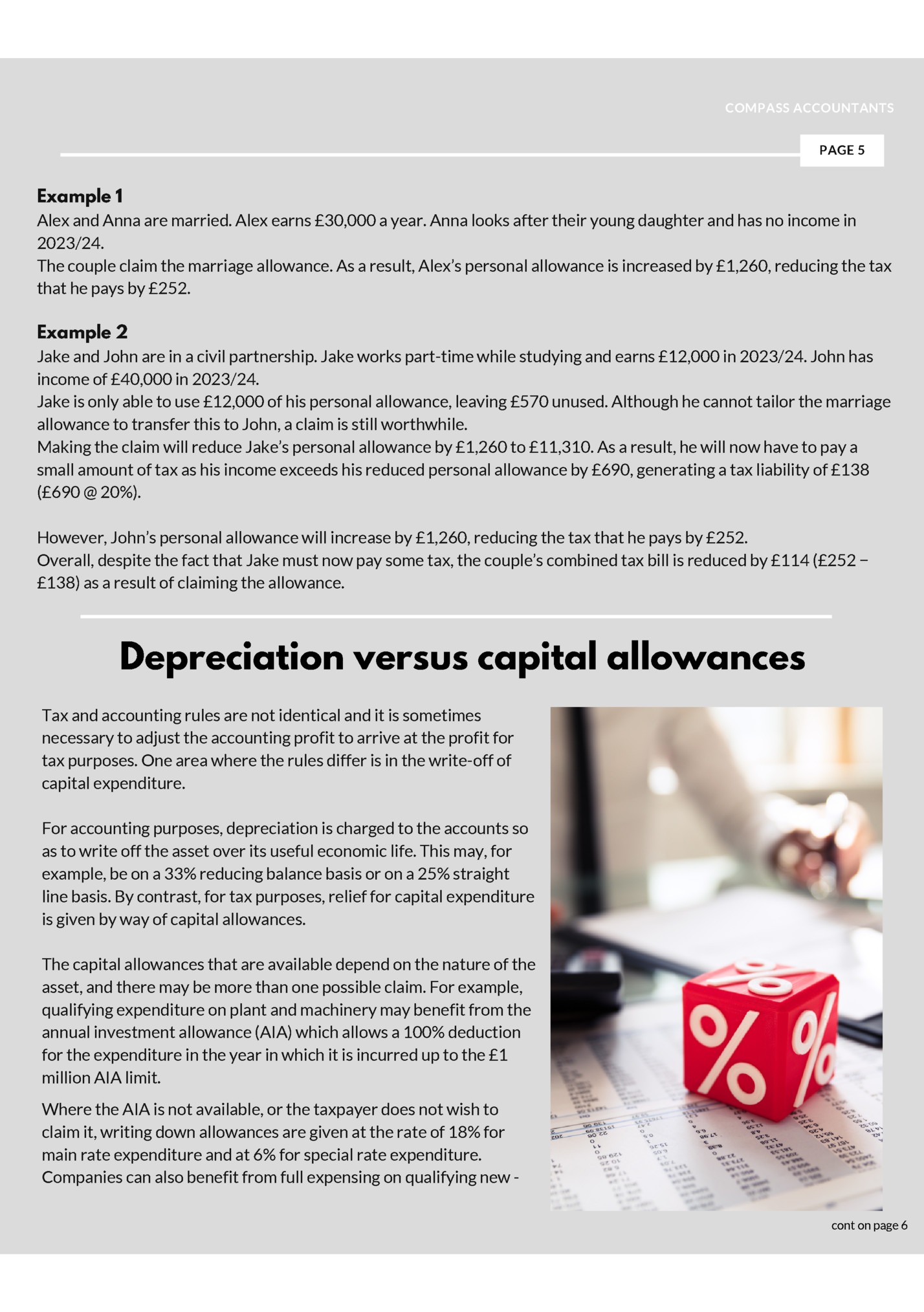
PAGE 6 plant and machinery that would otherwise be eligible for main rate writing down allowances. Like the AIA, this provides immediate relief for the full amount of the expenditure but, unlike the AIA, the amount of expenditure that can benefit from full expensing is not capped. A 50% first-year allowance is available to companies on new qualifying assets that would otherwise qualify for special rate writing down allowances, as long as the expenditure is incurred on or before 31 March 2026. This can be useful if the AIA has been used up. Firstyear allowances are available at a 100% rate for new zero emission cars. This again is beneficial as expenditure on cars does not qualify for the AIA, full expensing or the 50% first-year allowance available to companies. Adjusting the profit As a result of the differences between depreciation and capital allowances, it is necessary to make an adjustment to the accounting profit to arrive at the taxable profit. Depreciation must be added back to the accounting profit and capital allowances deducted (or balancing charges added) to arrive at the taxable profit. Further adjustments may be needed for other expenses that are not allowable for tax purposes, such as entertaining expenses. Where the AIA or full expensing is claimed, relief is given in full for tax purposes earlier than for accounting purposes. This means that the taxable profit will be lower than the accounting profit in the year in which the expenditure is incurred, but in subsequent years the accounting profit will be lower as depreciation will continue to be charged but the capital allowances have already been given. Example A Ltd is a new company and spends £200,000 on plant and machinery on which it claims the AIA. For accounting purposes, depreciation is charged at 30% on a reducing balance basis. The accounting profit for the year is £350,000 after charging depreciation of £60,000. To arrive at the taxable profit, the depreciation of £60,000 must be added back, but the company can deduct the capital allowances of £200,000. The taxable profit is therefore £210,000.
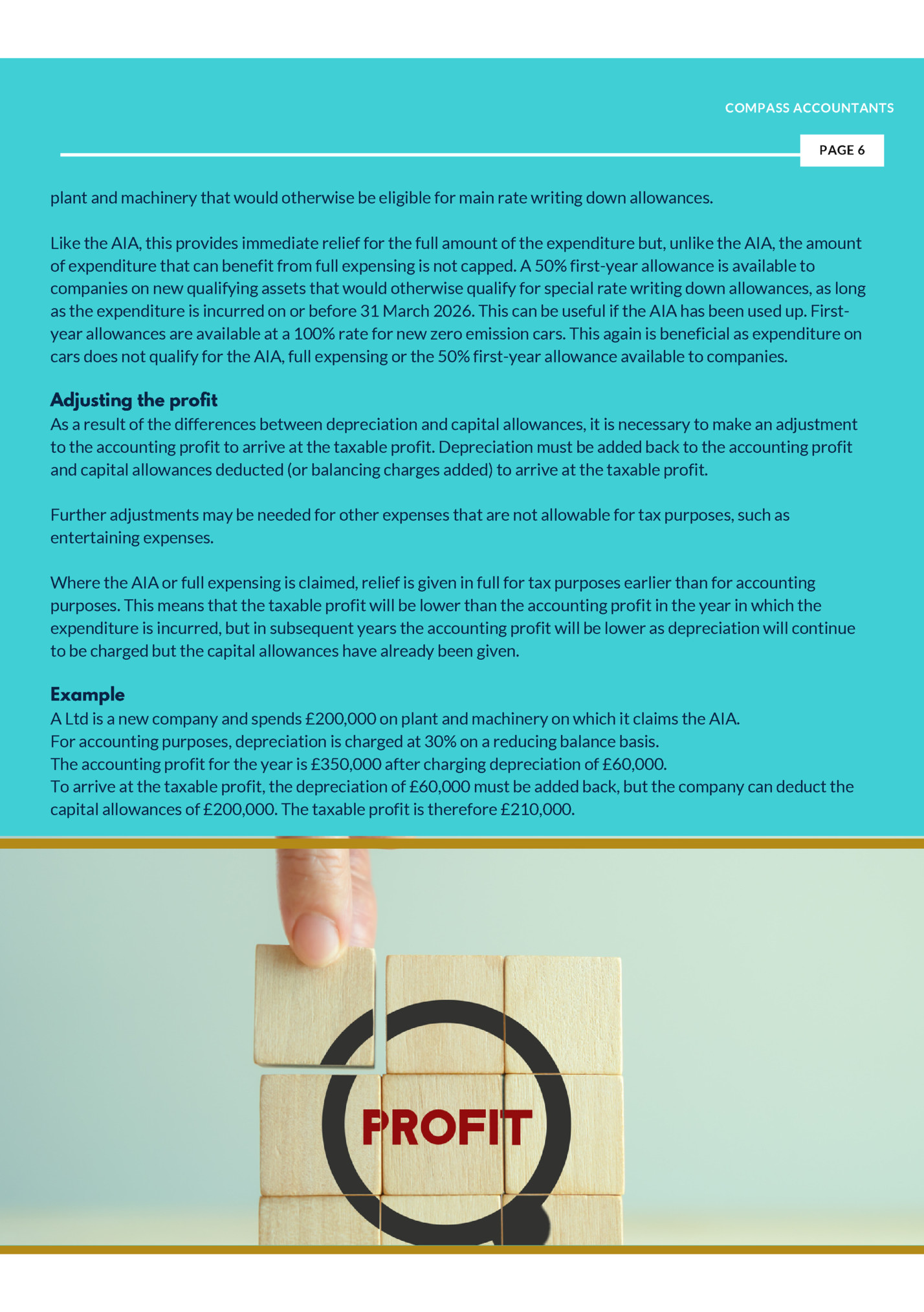
PAGE 7 Reporting payment to HMRC if you pay your employees early in December Strict reporting deadlines apply under Real Time Information (RTI). Employers are required to report employees’ pay and deductions to HMRC electronically on the Full Payment Submission (FPS) at or before the time that the payment is made to the employee. Employers who report late for more than one tax month in the tax year are charged penalties. While HMRC do allow a three-day period of grace and will not charge a penalty if the employer occasionally reports in this window, this is a concession rather than an extension to the deadline and should not be relied on. In December, many employers opt to pay their employees on a day other than their usual payday. This may be because the normal payday falls on a bank holiday or because the business closes over the Christmas and New Year period. An employer may also choose to pay employees early in December as a goodwill gesture. In 2019 HMRC introduced a permanent easement where employers paid their employees earlier than usual over the Christmas period. Rather than requiring pay and deductions to be reported by the actual payment date, instead the employer should use their usual or contractual pay date as the payment date in the FPS and ensure that it reaches HMRC by that date. As long as the FPS is submitted by the usual payday it will not be regarded as late by HMRC, even if the employees were paid on an earlier date. The reason for the easement is to help protect employees’ entitlement to Universal Credit. Example An employer normally pays its employees on the last Friday of the month. In December, this falls on 29 December 2023. However, as the employer shuts during the Christmas week, opening again on 2 January 2024, employees are instead paid on the last working day in December, which is Friday 22 December 2023. While it may be convenient to send the FPS when running the payroll on that date, the employer should still report the payment date as the usual payday of 29 December 2023. As long as the FPS is submitted by 29 December 2023 it will be treated as having been filed on time.

PAGE 8 TAX DIARY DECEMBER 2023 1 December 2023 - Due date for Corporation Tax payable for the year ended 28 February 2023. 19 December 2023 - PAYE and NIC deductions due for month ended 5 December 2023. (If you pay your tax electronically the due date is 22 December 2023). 19 December 2023 - Filing deadline for the CIS300 monthly return for the month ended 5 December 2023. 19 December 2023 - CIS tax deducted for the month ended 5 December 2023 is payable by today. 30 December 2023 - Deadline for filing 2022-23 self-assessment tax returns online to include a claim for under payments to be collected via tax code in 2024-25 For further information on any of the stories in this month’s newsletter, or for any other matter that Compass Accountants can assist you with, please contact us on 01329 844145 or contact@compassaccountants.co.uk To subscribe to the newsletter, so that each edition is delivered to your inbox, go to www.compassaccountants.co.uk and add your contact details. Compass Accountants, Venture House, The Tanneries, East Street, Titchfield Hampshire. PO14 4AR
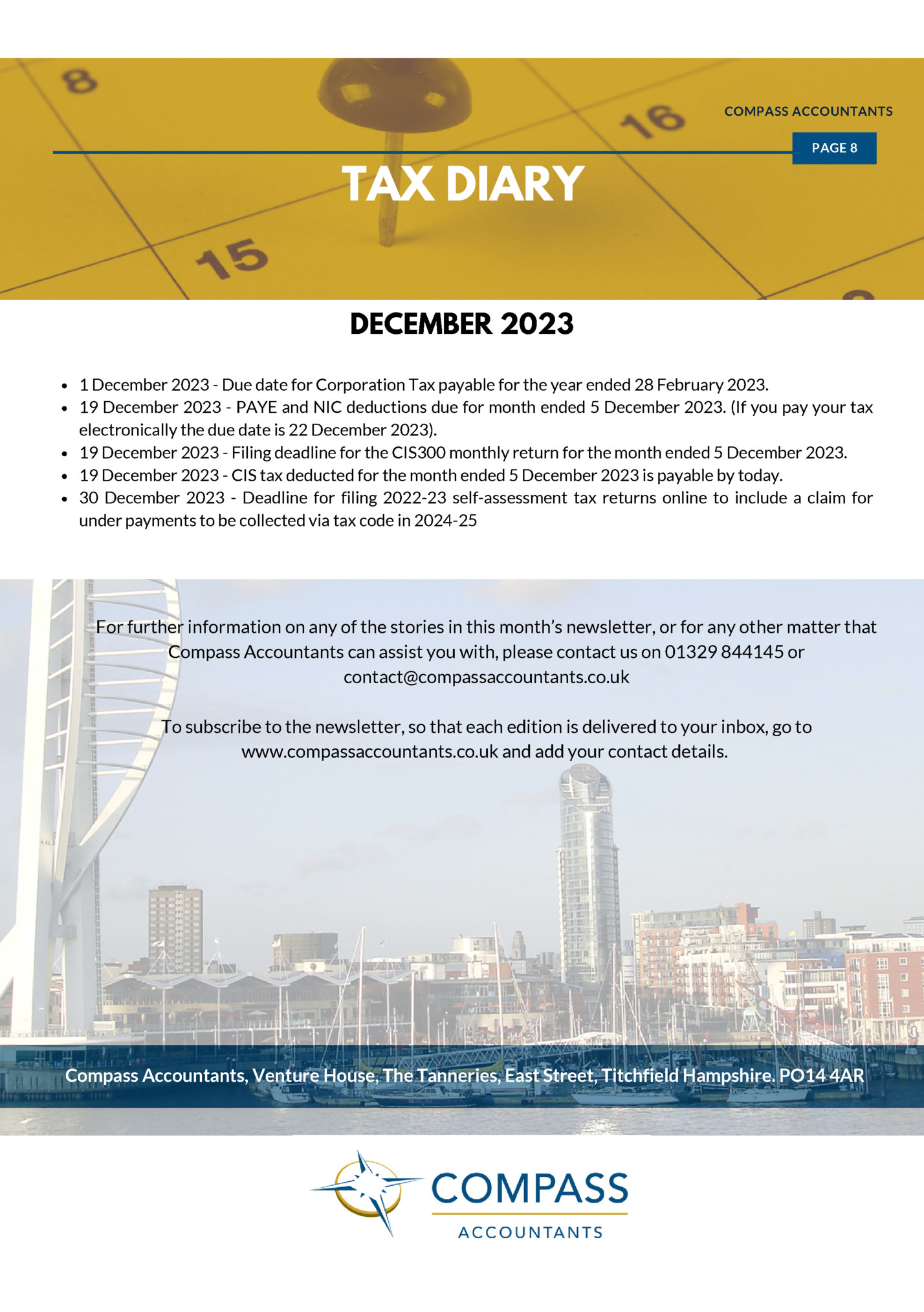
Fleepit Digital © 2021